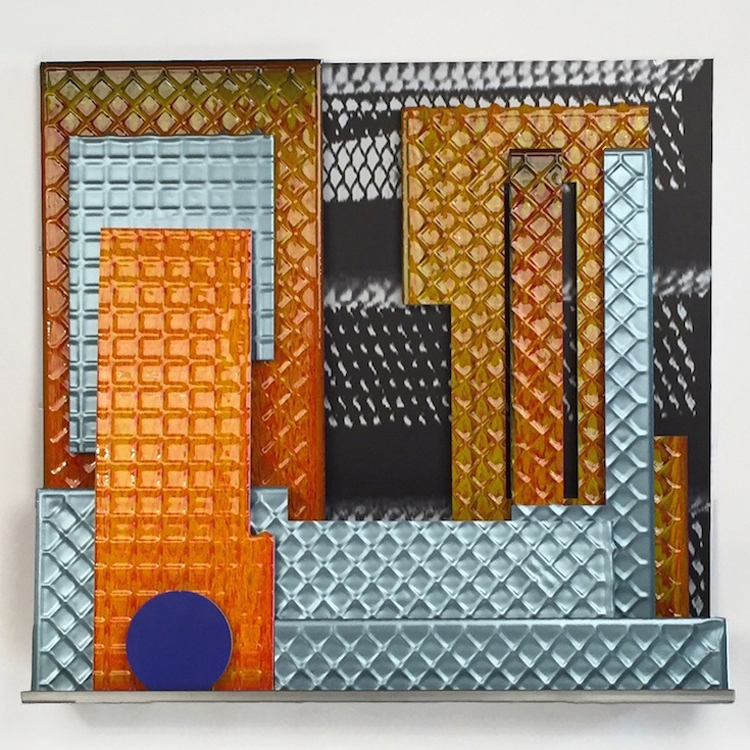Harvey/Meadows Gallery’s recent contemporary ceramics exhibition Defining Visual Culture (Aspen, Colorado, December 20, 2015 – January 16, 2016) combined the work of Robert Brady, Tony Marsh, and Robert Silverman for a dynamic experience in image, form, and light. Together, the trio explores prominent experiences in modern visual culture ranging from Brady’s references to the graphic image to Silverman’s focus on color and icons of urban landscape, to Marsh’s familiar domestic forms, deconstructed.
Above Image: Robert Silverman, Untitled 1. Photograph courtesy of Harvey/Meadows Gallery.

Tony Marsh, Perforated Vessel and Contents Series No. 4. Photograph courtesy of Harvey/Meadows Gallery.
Tony Marsh, a celebrated sculptor and Program Chair of Ceramic Arts for more than 25 years at California State University, Long Beach, covers the domestic realm of visual culture with his perforated arrangements. He builds thin porcelain forms and then deconstructs them with tiny evenly spaced holes, filling the voids with light and achieving a virgin sense of how an object sits in space. The objects deceptively imply that everything is exposed, but still hide moments of their interior. The experience feels like movement in your peripheral vision alluding direct focus, making you feel slightly insane, but finding comfort in knowing that no one else can sense your hallucinatory struggles. The artist explains:
“There is something ironic if not dynamic about taking a material like clay which is dense, opaque and ruled by gravity, creating eggshell thin forms and then removing as much material as possible, one hole at a time, and replacing material with light. The more material I remove, the more visually intense the work becomes.”
Marsh also showed a piece from his Terra Cotta House Series that is a departure from his airy, light-filled work.
“Most things I make carry the DNA of the work that came before. However, this work in some ways a bit of a departure. The construction of all phases from start to finish, is based primarily on right angles, something I have oddly never done. Adding to the list of ‘firsts’ would also be the fact that there is no added fired surface to finish the work.”

Robert Silverman, Untitled 2. Photograph courtesy of Harvey/Meadows Gallery.
Robert Silverman is an artist and designer who lives and works in New York City. His work has been exhibited internationally and is in a long list of public and private collections including the Museum of Arts and Design, New York City; the European Ceramic Work Center’s’ Hertogenbosch, The Netherlands; and The Mint Museum, Charlotte, North Carolina.
Robert Silverman’s work in Defining Visual Culture takes a step away from the minimalist tile paintings he is known for. His Untitled series layers colored tiles referencing cityscapes, urban environments, and industry. The geometric compositions are rigid, but softened by subtle plays with gravity in Untitled 2 and 3, where the dripping glaze is curiously pulled everywhere but towards the earth. The compositions are images, rotated, cut, layered, and abstracted into the essence of an average urban moment.

Robert Brady, Claw. Photograph courtesy of Harvey/Meadows Gallery.
Robert Brady’s Claw, and Throne, are important pieces in the exhibition, touching on the digital experience, a major aspect of modern visual culture. His graphic paintings avoid the coldness of digital design by balancing in the third dimension. They are slightly bent and cut, like paper, referencing the face, and tribal art with Ellsworth Kelly flavor.
Justin Crowe is a Writer and Director of Operations at cfile.daily.
What do you think of the contemporary ceramics in Defining Visual Culture? Share your thoughts in the comments!

Robert Brady, Language Series No. 2. Photograph courtesy of Harvey/Meadows Gallery.

Robert Brady, Language Series No. 3. Photograph courtesy of Harvey/Meadows Gallery.

Tony March, Perforated Cylinder with Attachments. Photograph courtesy of Harvey/Meadows Gallery.

Tony Marsh, Perforated Vessel and Contents Series No 7 (detail). Photograph courtesy of Harvey/Meadows Gallery. Click to see a larger image.

Tony Marsh, Perforated Vessel and Contents Series No. 7, 2012, 5 x 32 x 13 inches. Photograph courtesy of Harvey/Meadows Gallery. Click to see a larger image.

Tony Marsh, Terra Cotta House No. 2. Photograph courtesy of Harvey/Meadows Gallery. Click to see a larger image.

Tony Marsh, Terra Cotta House No. 2. Photograph courtesy of Harvey/Meadows Gallery.

Robert Brady, Throne. Photograph courtesy of Harvey/Meadows Gallery.

Robert Silverman, Untitled 3. Photograph courtesy of Harvey/Meadows Gallery. Click to see a larger image.

Robert Silverman, Untitled 2. Photograph courtesy of Harvey/Meadows Gallery.

Add your valued opinion to this post.